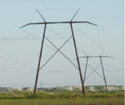 | 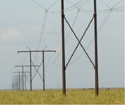 |
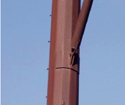 | 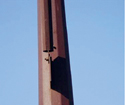 |
| Change. New structure design (right) replaced clevis connection. | |
Loose bolts contributed to the collapse of 30 extra-high-voltage transmission towers as Hurricane Wilma moved across South Florida, an independent engineering analysis has determined. The October 2005 storm crippled Florida Power & Light Co.’s electrical system.
The 30 steel-pole H-frame structures on FPL’s Conservation-Corbett 500-kV transmission line between Palm Beach and Broward counties failed completely. Juno Beach, Fla.-based FPL retained KEMA Inc., a Dutch engineering firm, to investigate the performance of its electrical infrastructure during the storm. KEMA found that hand tightening of crossbrace connection bolts, a foundation failure resulting from faulty installation and one tensile failure together could have initiated a cascading affect bringing down the H-frames.
More than 3 million FPL customers lost power in the storm, which was rated Category 3 at landfall, near where the line fell.
New Design
The line was built in 1996 in accordance with the National Electrical Safety Code, manufacturer’s guidelines and general industry standards, which require tightening with manual torque wrenches, says Richard E. Brown, senior principal consultant in KEMA’s Raleigh, N.C., office. But FPL had just adopted a new transmission line design, which used a higher tension on the conductors. “They strung them tighter,” Brown says. “When you string them tighter, they are more susceptible to vibration.”
The new design also replaced a clevis-type connection between the crossbrace and pole with a direct connection using a plate welded to the pole, according to the KEMA report. The two plates are connected by a single bolt and nut, without washers or locking devices.
The report says manually tightening the bolts could be difficult if a small offset exists between the plate and crossbrace. “Tightening of the bolt would only be possible if at the same time this offset is corrected,” it says.
The line experienced aeolian, or wind-induced, vibration problems in 1998. While assessing the line, crews noticed some loose or missing bolts and likely hand-tightened them, the report says. FPL also put vibration dampers on the conductors to solve the problem.
“What likely happened is they went back to check on whether the vibration problem was corrected, and it was,” Brown says. “Conductor vibration was reduced to a level below where conductor damage would occur. But it appears that vibra-tion was not below where loosening of the bolts could recur.”
The investigation found no inspection record data showing that bolts were loose or missing before last year, but could not determine when the structures were last inspected. FPL inspects 500-kV transmission lines on a four-year, 10% sample inspection, which KEMA concludes may not have been sufficient to detect the bolt problem.
FPL declined to comment, discuss the utility’s plans to harden its system or disclose the location of the Conservation-Corbett line. The Public Service Commission also declined to comment.
Since the storm, FPL has tightened the bolts on the connection with about 4,600 ft-lb of torque, says the report. FPL also is deliberately damaging the threads so the bolts stay in place permanently. Neither is a standard industry practice, according to Brown.
KEMA also found that when one structure failed, the lines pulled adjacent ones down as well. “We would have a row of six, 10, 15 structures that all came down, probably initiated by a single pole coming down,” Brown says. “The weight transfer to the adjacent poles was devastating in the hurricane and resulted in cascading failures.”
FPL filed KEMA’s report last month along with a petition to the Florida Public Service Commission to establish a storm-recovery financing plan that would eliminate a $1-billion deficit in its storm reserve and help to build a new reserve. The plan includes issuing bonds to pay for storm-related repairs and imposing a customer storm surcharge. Alternatively, the utility asked for a higher surcharge.

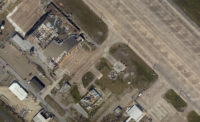
Post a comment to this article
Report Abusive Comment